Outdoor Air | Environmental Health Issue
VerifiedAdded on 2022/09/14
|12
|2784
|11
AI Summary
Contribute Materials
Your contribution can guide someone’s learning journey. Share your
documents today.
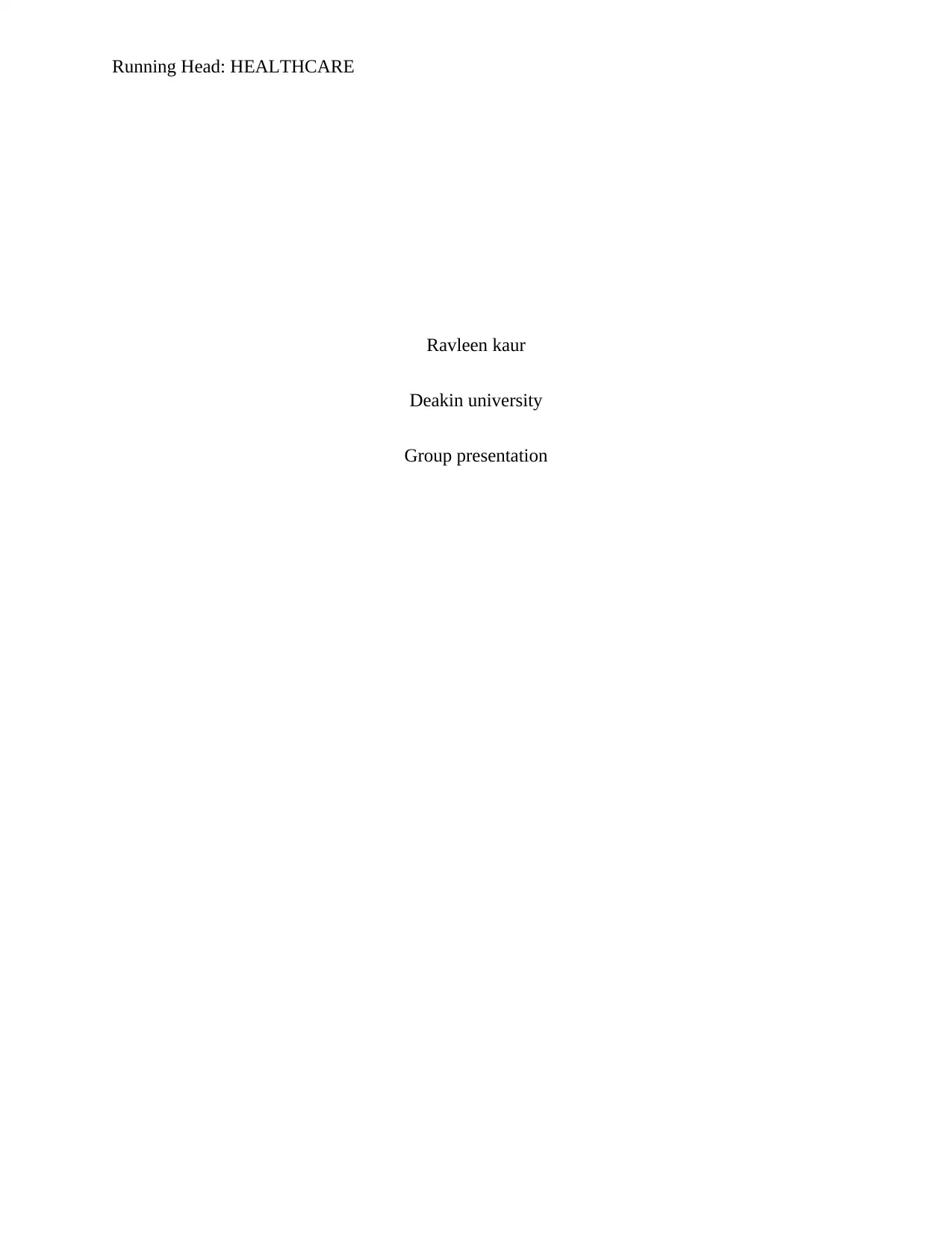
Running Head: HEALTHCARE
Ravleen kaur
Deakin university
Group presentation
Ravleen kaur
Deakin university
Group presentation
Secure Best Marks with AI Grader
Need help grading? Try our AI Grader for instant feedback on your assignments.
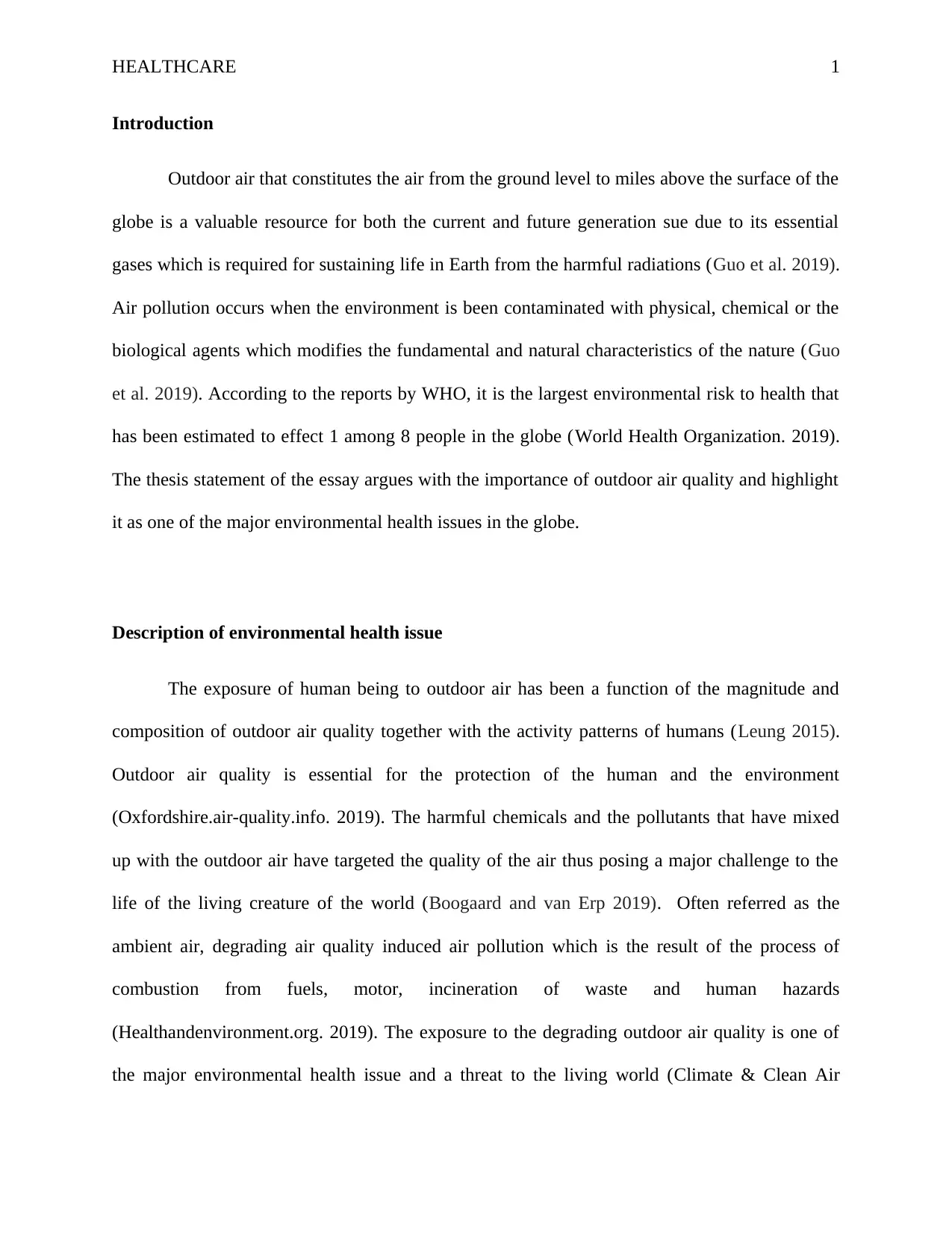
HEALTHCARE 1
Introduction
Outdoor air that constitutes the air from the ground level to miles above the surface of the
globe is a valuable resource for both the current and future generation sue due to its essential
gases which is required for sustaining life in Earth from the harmful radiations (Guo et al. 2019).
Air pollution occurs when the environment is been contaminated with physical, chemical or the
biological agents which modifies the fundamental and natural characteristics of the nature (Guo
et al. 2019). According to the reports by WHO, it is the largest environmental risk to health that
has been estimated to effect 1 among 8 people in the globe (World Health Organization. 2019).
The thesis statement of the essay argues with the importance of outdoor air quality and highlight
it as one of the major environmental health issues in the globe.
Description of environmental health issue
The exposure of human being to outdoor air has been a function of the magnitude and
composition of outdoor air quality together with the activity patterns of humans (Leung 2015).
Outdoor air quality is essential for the protection of the human and the environment
(Oxfordshire.air-quality.info. 2019). The harmful chemicals and the pollutants that have mixed
up with the outdoor air have targeted the quality of the air thus posing a major challenge to the
life of the living creature of the world (Boogaard and van Erp 2019). Often referred as the
ambient air, degrading air quality induced air pollution which is the result of the process of
combustion from fuels, motor, incineration of waste and human hazards
(Healthandenvironment.org. 2019). The exposure to the degrading outdoor air quality is one of
the major environmental health issue and a threat to the living world (Climate & Clean Air
Introduction
Outdoor air that constitutes the air from the ground level to miles above the surface of the
globe is a valuable resource for both the current and future generation sue due to its essential
gases which is required for sustaining life in Earth from the harmful radiations (Guo et al. 2019).
Air pollution occurs when the environment is been contaminated with physical, chemical or the
biological agents which modifies the fundamental and natural characteristics of the nature (Guo
et al. 2019). According to the reports by WHO, it is the largest environmental risk to health that
has been estimated to effect 1 among 8 people in the globe (World Health Organization. 2019).
The thesis statement of the essay argues with the importance of outdoor air quality and highlight
it as one of the major environmental health issues in the globe.
Description of environmental health issue
The exposure of human being to outdoor air has been a function of the magnitude and
composition of outdoor air quality together with the activity patterns of humans (Leung 2015).
Outdoor air quality is essential for the protection of the human and the environment
(Oxfordshire.air-quality.info. 2019). The harmful chemicals and the pollutants that have mixed
up with the outdoor air have targeted the quality of the air thus posing a major challenge to the
life of the living creature of the world (Boogaard and van Erp 2019). Often referred as the
ambient air, degrading air quality induced air pollution which is the result of the process of
combustion from fuels, motor, incineration of waste and human hazards
(Healthandenvironment.org. 2019). The exposure to the degrading outdoor air quality is one of
the major environmental health issue and a threat to the living world (Climate & Clean Air
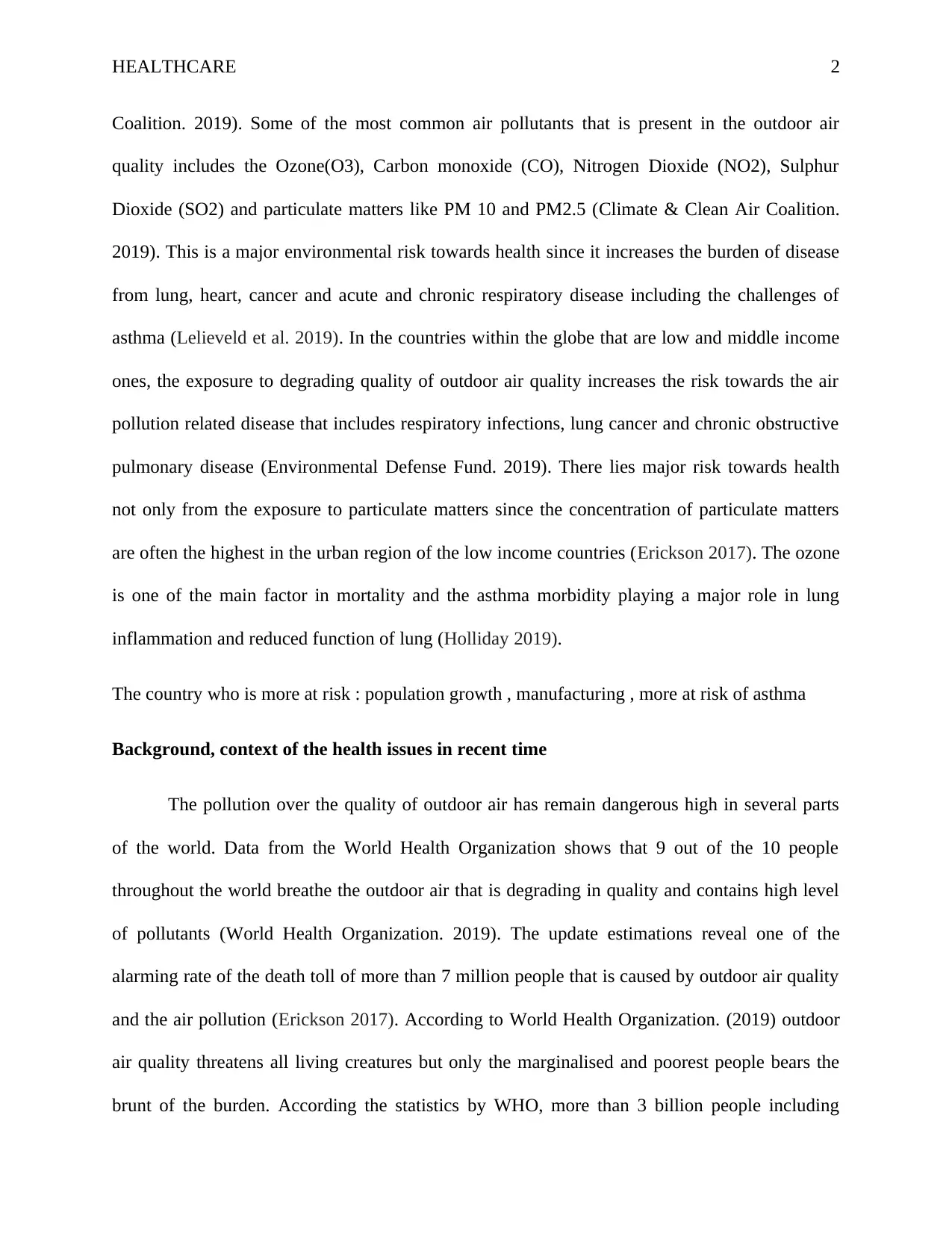
HEALTHCARE 2
Coalition. 2019). Some of the most common air pollutants that is present in the outdoor air
quality includes the Ozone(O3), Carbon monoxide (CO), Nitrogen Dioxide (NO2), Sulphur
Dioxide (SO2) and particulate matters like PM 10 and PM2.5 (Climate & Clean Air Coalition.
2019). This is a major environmental risk towards health since it increases the burden of disease
from lung, heart, cancer and acute and chronic respiratory disease including the challenges of
asthma (Lelieveld et al. 2019). In the countries within the globe that are low and middle income
ones, the exposure to degrading quality of outdoor air quality increases the risk towards the air
pollution related disease that includes respiratory infections, lung cancer and chronic obstructive
pulmonary disease (Environmental Defense Fund. 2019). There lies major risk towards health
not only from the exposure to particulate matters since the concentration of particulate matters
are often the highest in the urban region of the low income countries (Erickson 2017). The ozone
is one of the main factor in mortality and the asthma morbidity playing a major role in lung
inflammation and reduced function of lung (Holliday 2019).
The country who is more at risk : population growth , manufacturing , more at risk of asthma
Background, context of the health issues in recent time
The pollution over the quality of outdoor air has remain dangerous high in several parts
of the world. Data from the World Health Organization shows that 9 out of the 10 people
throughout the world breathe the outdoor air that is degrading in quality and contains high level
of pollutants (World Health Organization. 2019). The update estimations reveal one of the
alarming rate of the death toll of more than 7 million people that is caused by outdoor air quality
and the air pollution (Erickson 2017). According to World Health Organization. (2019) outdoor
air quality threatens all living creatures but only the marginalised and poorest people bears the
brunt of the burden. According the statistics by WHO, more than 3 billion people including
Coalition. 2019). Some of the most common air pollutants that is present in the outdoor air
quality includes the Ozone(O3), Carbon monoxide (CO), Nitrogen Dioxide (NO2), Sulphur
Dioxide (SO2) and particulate matters like PM 10 and PM2.5 (Climate & Clean Air Coalition.
2019). This is a major environmental risk towards health since it increases the burden of disease
from lung, heart, cancer and acute and chronic respiratory disease including the challenges of
asthma (Lelieveld et al. 2019). In the countries within the globe that are low and middle income
ones, the exposure to degrading quality of outdoor air quality increases the risk towards the air
pollution related disease that includes respiratory infections, lung cancer and chronic obstructive
pulmonary disease (Environmental Defense Fund. 2019). There lies major risk towards health
not only from the exposure to particulate matters since the concentration of particulate matters
are often the highest in the urban region of the low income countries (Erickson 2017). The ozone
is one of the main factor in mortality and the asthma morbidity playing a major role in lung
inflammation and reduced function of lung (Holliday 2019).
The country who is more at risk : population growth , manufacturing , more at risk of asthma
Background, context of the health issues in recent time
The pollution over the quality of outdoor air has remain dangerous high in several parts
of the world. Data from the World Health Organization shows that 9 out of the 10 people
throughout the world breathe the outdoor air that is degrading in quality and contains high level
of pollutants (World Health Organization. 2019). The update estimations reveal one of the
alarming rate of the death toll of more than 7 million people that is caused by outdoor air quality
and the air pollution (Erickson 2017). According to World Health Organization. (2019) outdoor
air quality threatens all living creatures but only the marginalised and poorest people bears the
brunt of the burden. According the statistics by WHO, more than 3 billion people including
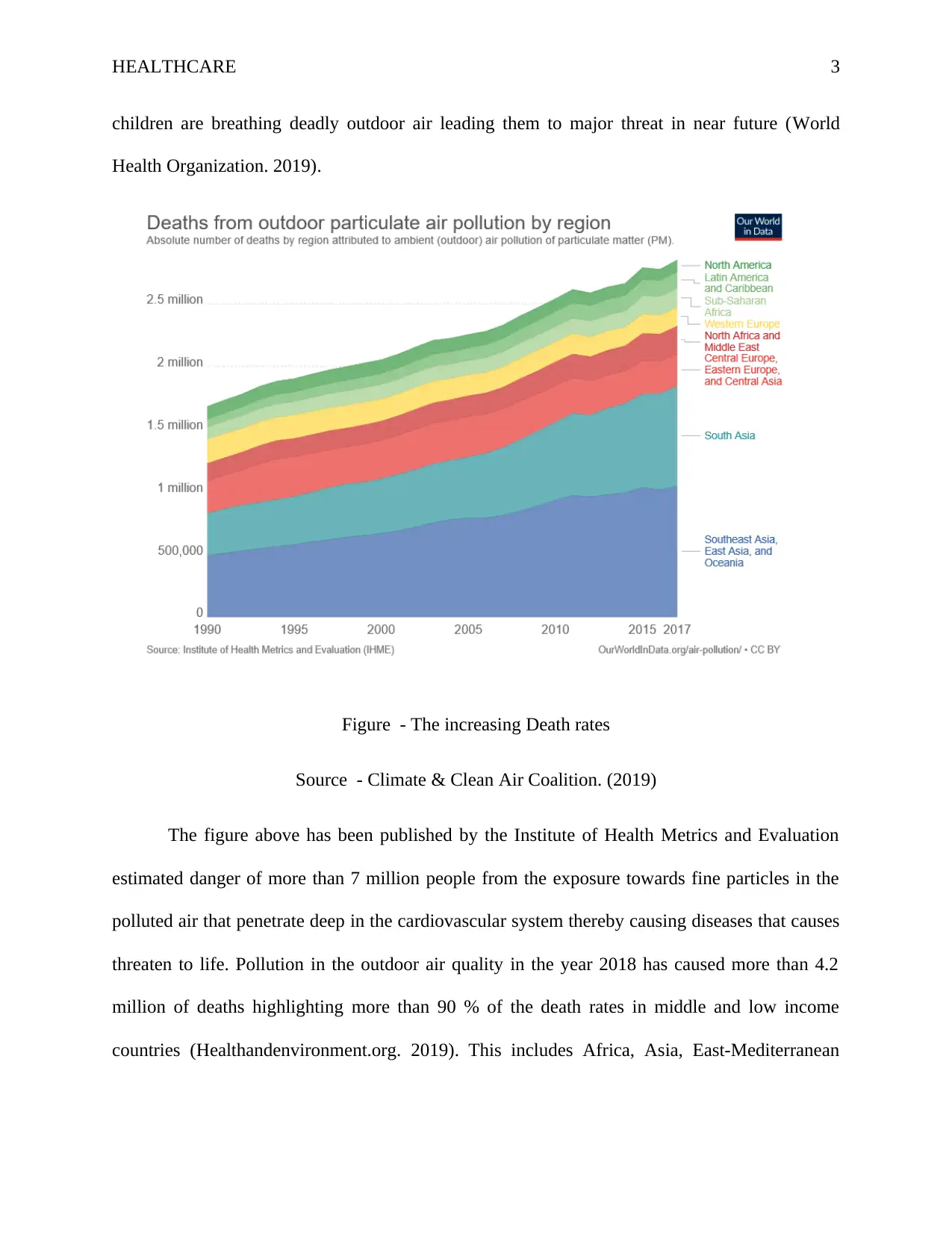
HEALTHCARE 3
children are breathing deadly outdoor air leading them to major threat in near future (World
Health Organization. 2019).
Figure - The increasing Death rates
Source - Climate & Clean Air Coalition. (2019)
The figure above has been published by the Institute of Health Metrics and Evaluation
estimated danger of more than 7 million people from the exposure towards fine particles in the
polluted air that penetrate deep in the cardiovascular system thereby causing diseases that causes
threaten to life. Pollution in the outdoor air quality in the year 2018 has caused more than 4.2
million of deaths highlighting more than 90 % of the death rates in middle and low income
countries (Healthandenvironment.org. 2019). This includes Africa, Asia, East-Mediterranean
children are breathing deadly outdoor air leading them to major threat in near future (World
Health Organization. 2019).
Figure - The increasing Death rates
Source - Climate & Clean Air Coalition. (2019)
The figure above has been published by the Institute of Health Metrics and Evaluation
estimated danger of more than 7 million people from the exposure towards fine particles in the
polluted air that penetrate deep in the cardiovascular system thereby causing diseases that causes
threaten to life. Pollution in the outdoor air quality in the year 2018 has caused more than 4.2
million of deaths highlighting more than 90 % of the death rates in middle and low income
countries (Healthandenvironment.org. 2019). This includes Africa, Asia, East-Mediterranean
Secure Best Marks with AI Grader
Need help grading? Try our AI Grader for instant feedback on your assignments.
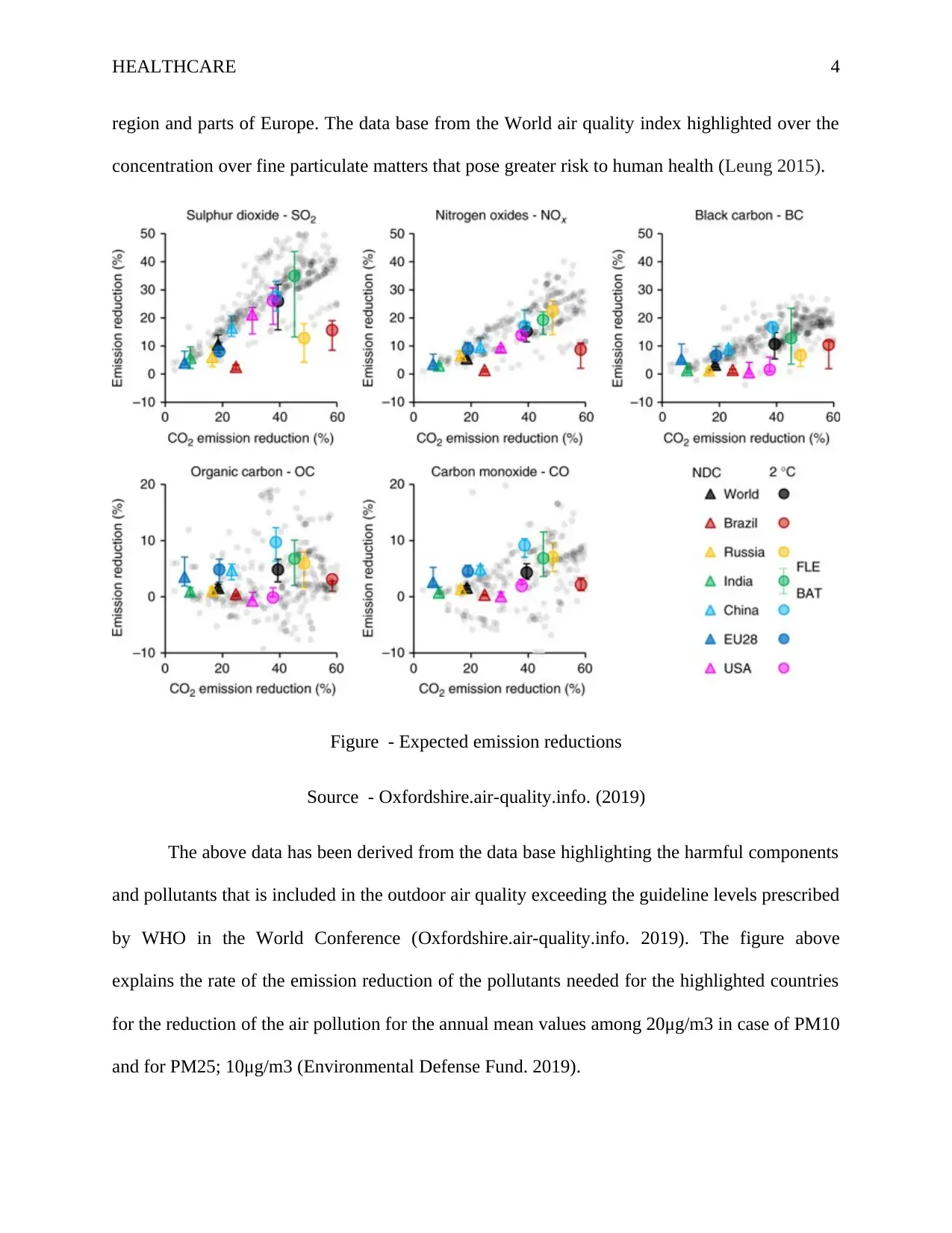
HEALTHCARE 4
region and parts of Europe. The data base from the World air quality index highlighted over the
concentration over fine particulate matters that pose greater risk to human health (Leung 2015).
Figure - Expected emission reductions
Source - Oxfordshire.air-quality.info. (2019)
The above data has been derived from the data base highlighting the harmful components
and pollutants that is included in the outdoor air quality exceeding the guideline levels prescribed
by WHO in the World Conference (Oxfordshire.air-quality.info. 2019). The figure above
explains the rate of the emission reduction of the pollutants needed for the highlighted countries
for the reduction of the air pollution for the annual mean values among 20μg/m3 in case of PM10
and for PM25; 10μg/m3 (Environmental Defense Fund. 2019).
region and parts of Europe. The data base from the World air quality index highlighted over the
concentration over fine particulate matters that pose greater risk to human health (Leung 2015).
Figure - Expected emission reductions
Source - Oxfordshire.air-quality.info. (2019)
The above data has been derived from the data base highlighting the harmful components
and pollutants that is included in the outdoor air quality exceeding the guideline levels prescribed
by WHO in the World Conference (Oxfordshire.air-quality.info. 2019). The figure above
explains the rate of the emission reduction of the pollutants needed for the highlighted countries
for the reduction of the air pollution for the annual mean values among 20μg/m3 in case of PM10
and for PM25; 10μg/m3 (Environmental Defense Fund. 2019).
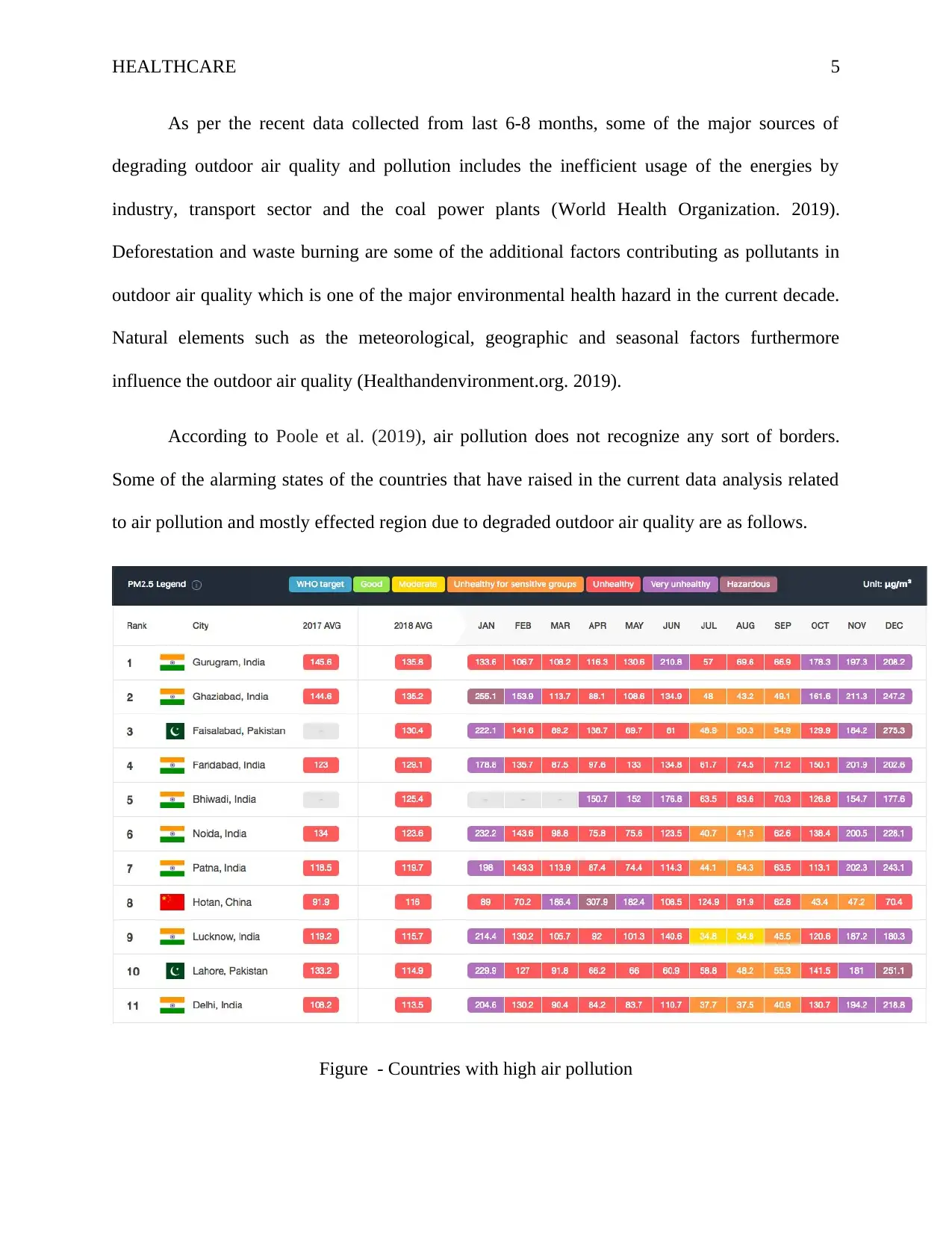
HEALTHCARE 5
As per the recent data collected from last 6-8 months, some of the major sources of
degrading outdoor air quality and pollution includes the inefficient usage of the energies by
industry, transport sector and the coal power plants (World Health Organization. 2019).
Deforestation and waste burning are some of the additional factors contributing as pollutants in
outdoor air quality which is one of the major environmental health hazard in the current decade.
Natural elements such as the meteorological, geographic and seasonal factors furthermore
influence the outdoor air quality (Healthandenvironment.org. 2019).
According to Poole et al. (2019), air pollution does not recognize any sort of borders.
Some of the alarming states of the countries that have raised in the current data analysis related
to air pollution and mostly effected region due to degraded outdoor air quality are as follows.
Figure - Countries with high air pollution
As per the recent data collected from last 6-8 months, some of the major sources of
degrading outdoor air quality and pollution includes the inefficient usage of the energies by
industry, transport sector and the coal power plants (World Health Organization. 2019).
Deforestation and waste burning are some of the additional factors contributing as pollutants in
outdoor air quality which is one of the major environmental health hazard in the current decade.
Natural elements such as the meteorological, geographic and seasonal factors furthermore
influence the outdoor air quality (Healthandenvironment.org. 2019).
According to Poole et al. (2019), air pollution does not recognize any sort of borders.
Some of the alarming states of the countries that have raised in the current data analysis related
to air pollution and mostly effected region due to degraded outdoor air quality are as follows.
Figure - Countries with high air pollution
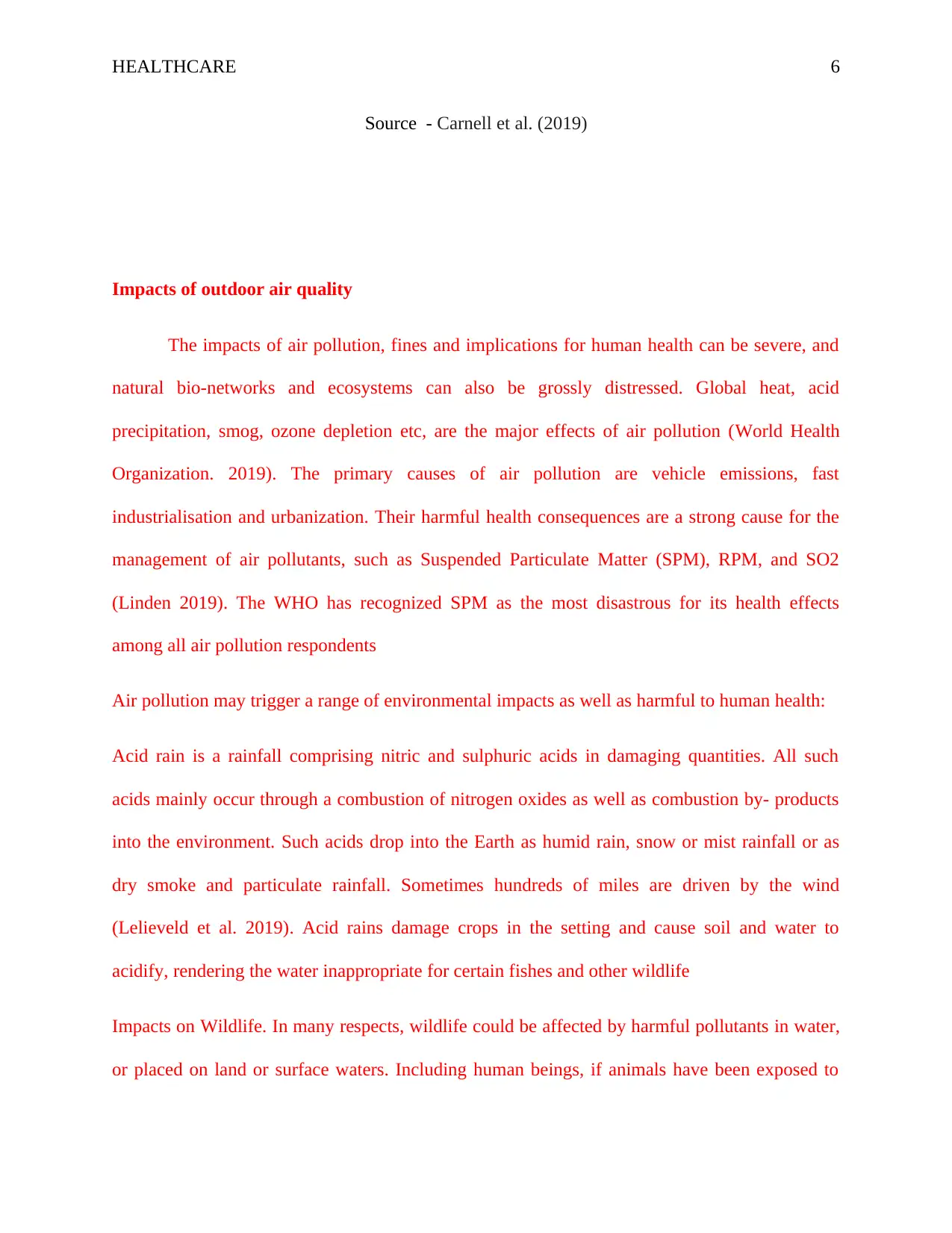
HEALTHCARE 6
Source - Carnell et al. (2019)
Impacts of outdoor air quality
The impacts of air pollution, fines and implications for human health can be severe, and
natural bio-networks and ecosystems can also be grossly distressed. Global heat, acid
precipitation, smog, ozone depletion etc, are the major effects of air pollution (World Health
Organization. 2019). The primary causes of air pollution are vehicle emissions, fast
industrialisation and urbanization. Their harmful health consequences are a strong cause for the
management of air pollutants, such as Suspended Particulate Matter (SPM), RPM, and SO2
(Linden 2019). The WHO has recognized SPM as the most disastrous for its health effects
among all air pollution respondents
Air pollution may trigger a range of environmental impacts as well as harmful to human health:
Acid rain is a rainfall comprising nitric and sulphuric acids in damaging quantities. All such
acids mainly occur through a combustion of nitrogen oxides as well as combustion by- products
into the environment. Such acids drop into the Earth as humid rain, snow or mist rainfall or as
dry smoke and particulate rainfall. Sometimes hundreds of miles are driven by the wind
(Lelieveld et al. 2019). Acid rains damage crops in the setting and cause soil and water to
acidify, rendering the water inappropriate for certain fishes and other wildlife
Impacts on Wildlife. In many respects, wildlife could be affected by harmful pollutants in water,
or placed on land or surface waters. Including human beings, if animals have been exposed to
Source - Carnell et al. (2019)
Impacts of outdoor air quality
The impacts of air pollution, fines and implications for human health can be severe, and
natural bio-networks and ecosystems can also be grossly distressed. Global heat, acid
precipitation, smog, ozone depletion etc, are the major effects of air pollution (World Health
Organization. 2019). The primary causes of air pollution are vehicle emissions, fast
industrialisation and urbanization. Their harmful health consequences are a strong cause for the
management of air pollutants, such as Suspended Particulate Matter (SPM), RPM, and SO2
(Linden 2019). The WHO has recognized SPM as the most disastrous for its health effects
among all air pollution respondents
Air pollution may trigger a range of environmental impacts as well as harmful to human health:
Acid rain is a rainfall comprising nitric and sulphuric acids in damaging quantities. All such
acids mainly occur through a combustion of nitrogen oxides as well as combustion by- products
into the environment. Such acids drop into the Earth as humid rain, snow or mist rainfall or as
dry smoke and particulate rainfall. Sometimes hundreds of miles are driven by the wind
(Lelieveld et al. 2019). Acid rains damage crops in the setting and cause soil and water to
acidify, rendering the water inappropriate for certain fishes and other wildlife
Impacts on Wildlife. In many respects, wildlife could be affected by harmful pollutants in water,
or placed on land or surface waters. Including human beings, if animals have been exposed to
Paraphrase This Document
Need a fresh take? Get an instant paraphrase of this document with our AI Paraphraser
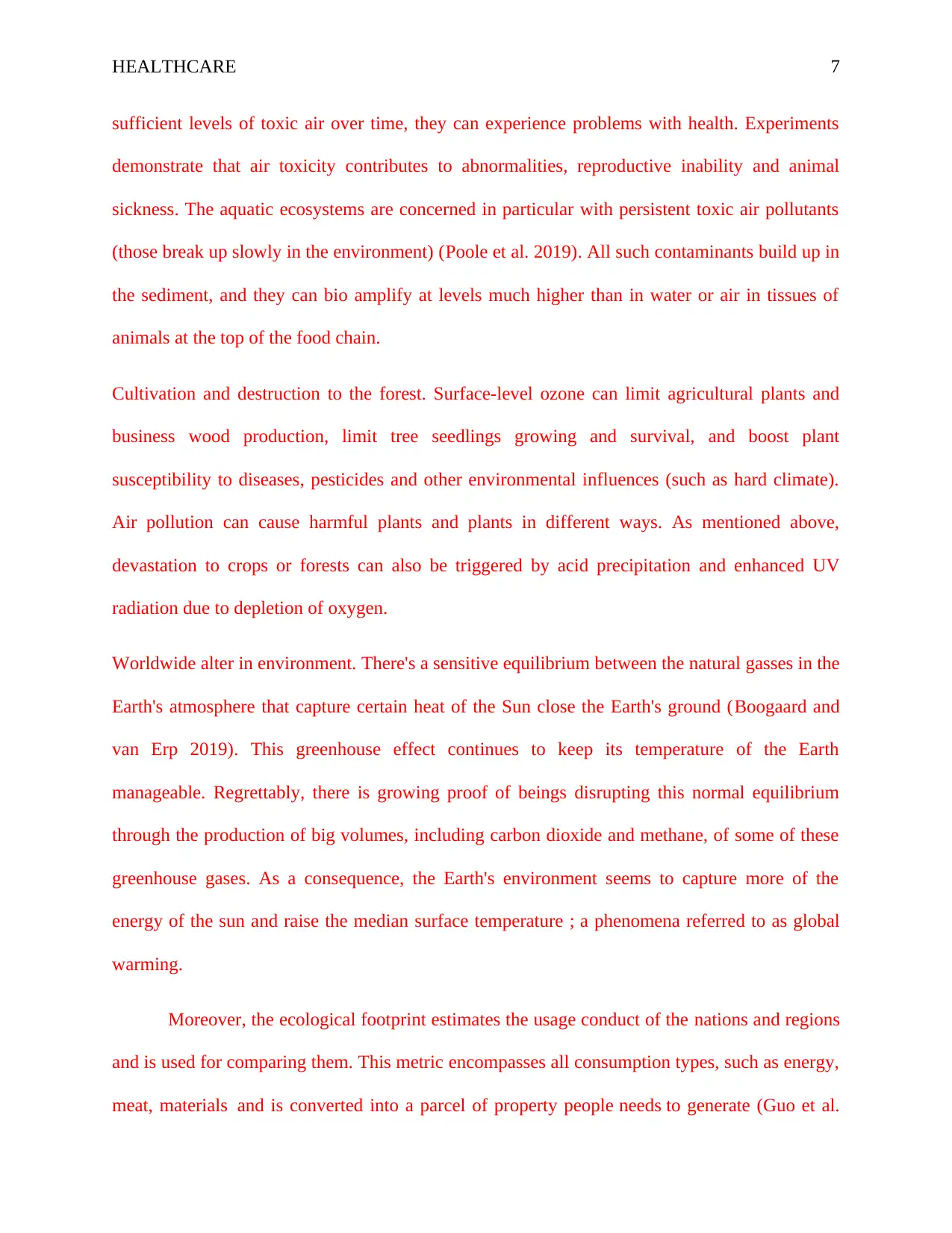
HEALTHCARE 7
sufficient levels of toxic air over time, they can experience problems with health. Experiments
demonstrate that air toxicity contributes to abnormalities, reproductive inability and animal
sickness. The aquatic ecosystems are concerned in particular with persistent toxic air pollutants
(those break up slowly in the environment) (Poole et al. 2019). All such contaminants build up in
the sediment, and they can bio amplify at levels much higher than in water or air in tissues of
animals at the top of the food chain.
Cultivation and destruction to the forest. Surface-level ozone can limit agricultural plants and
business wood production, limit tree seedlings growing and survival, and boost plant
susceptibility to diseases, pesticides and other environmental influences (such as hard climate).
Air pollution can cause harmful plants and plants in different ways. As mentioned above,
devastation to crops or forests can also be triggered by acid precipitation and enhanced UV
radiation due to depletion of oxygen.
Worldwide alter in environment. There's a sensitive equilibrium between the natural gasses in the
Earth's atmosphere that capture certain heat of the Sun close the Earth's ground (Boogaard and
van Erp 2019). This greenhouse effect continues to keep its temperature of the Earth
manageable. Regrettably, there is growing proof of beings disrupting this normal equilibrium
through the production of big volumes, including carbon dioxide and methane, of some of these
greenhouse gases. As a consequence, the Earth's environment seems to capture more of the
energy of the sun and raise the median surface temperature ; a phenomena referred to as global
warming.
Moreover, the ecological footprint estimates the usage conduct of the nations and regions
and is used for comparing them. This metric encompasses all consumption types, such as energy,
meat, materials and is converted into a parcel of property people needs to generate (Guo et al.
sufficient levels of toxic air over time, they can experience problems with health. Experiments
demonstrate that air toxicity contributes to abnormalities, reproductive inability and animal
sickness. The aquatic ecosystems are concerned in particular with persistent toxic air pollutants
(those break up slowly in the environment) (Poole et al. 2019). All such contaminants build up in
the sediment, and they can bio amplify at levels much higher than in water or air in tissues of
animals at the top of the food chain.
Cultivation and destruction to the forest. Surface-level ozone can limit agricultural plants and
business wood production, limit tree seedlings growing and survival, and boost plant
susceptibility to diseases, pesticides and other environmental influences (such as hard climate).
Air pollution can cause harmful plants and plants in different ways. As mentioned above,
devastation to crops or forests can also be triggered by acid precipitation and enhanced UV
radiation due to depletion of oxygen.
Worldwide alter in environment. There's a sensitive equilibrium between the natural gasses in the
Earth's atmosphere that capture certain heat of the Sun close the Earth's ground (Boogaard and
van Erp 2019). This greenhouse effect continues to keep its temperature of the Earth
manageable. Regrettably, there is growing proof of beings disrupting this normal equilibrium
through the production of big volumes, including carbon dioxide and methane, of some of these
greenhouse gases. As a consequence, the Earth's environment seems to capture more of the
energy of the sun and raise the median surface temperature ; a phenomena referred to as global
warming.
Moreover, the ecological footprint estimates the usage conduct of the nations and regions
and is used for comparing them. This metric encompasses all consumption types, such as energy,
meat, materials and is converted into a parcel of property people needs to generate (Guo et al.
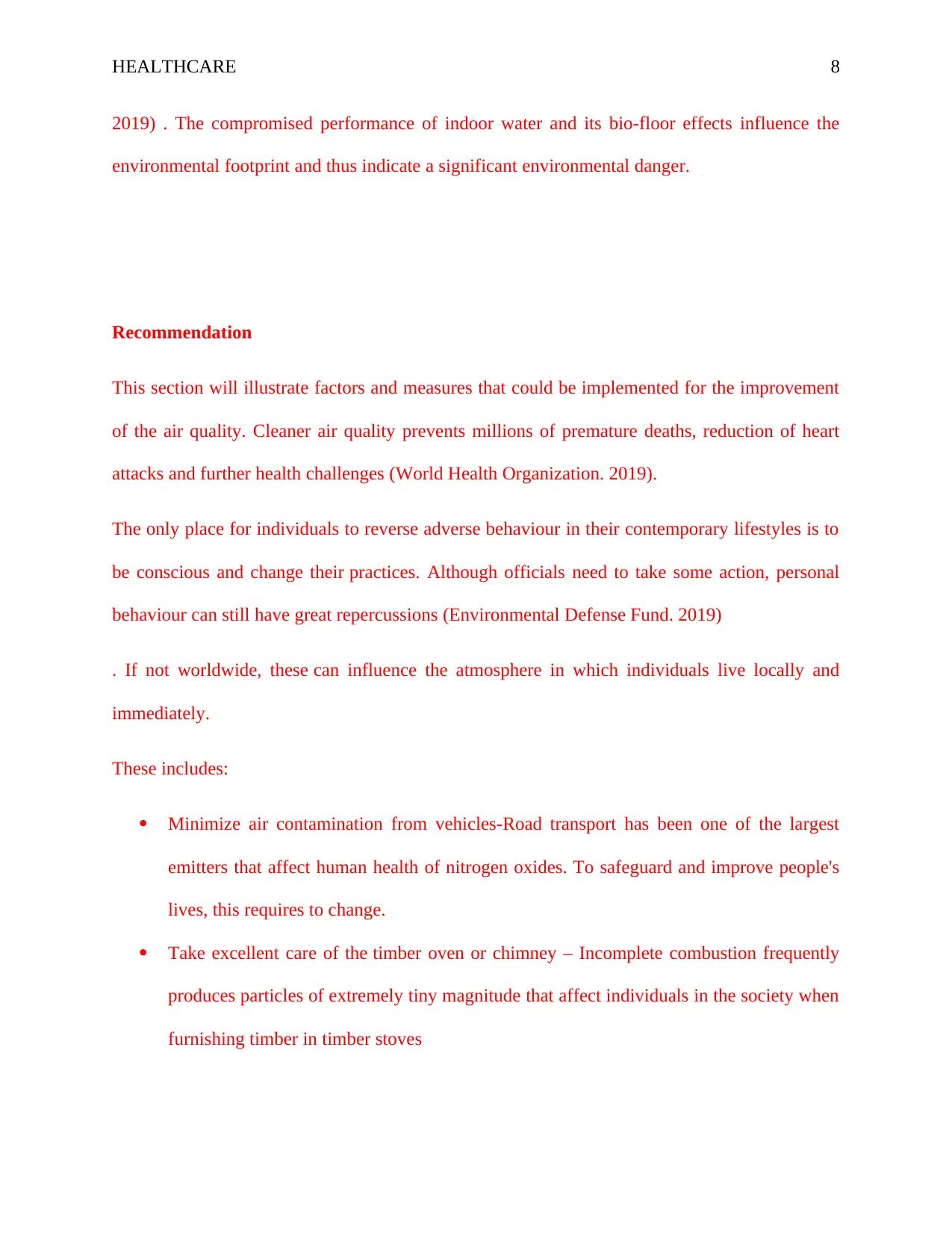
HEALTHCARE 8
2019) . The compromised performance of indoor water and its bio-floor effects influence the
environmental footprint and thus indicate a significant environmental danger.
Recommendation
This section will illustrate factors and measures that could be implemented for the improvement
of the air quality. Cleaner air quality prevents millions of premature deaths, reduction of heart
attacks and further health challenges (World Health Organization. 2019).
The only place for individuals to reverse adverse behaviour in their contemporary lifestyles is to
be conscious and change their practices. Although officials need to take some action, personal
behaviour can still have great repercussions (Environmental Defense Fund. 2019)
. If not worldwide, these can influence the atmosphere in which individuals live locally and
immediately.
These includes:
Minimize air contamination from vehicles-Road transport has been one of the largest
emitters that affect human health of nitrogen oxides. To safeguard and improve people's
lives, this requires to change.
Take excellent care of the timber oven or chimney – Incomplete combustion frequently
produces particles of extremely tiny magnitude that affect individuals in the society when
furnishing timber in timber stoves
2019) . The compromised performance of indoor water and its bio-floor effects influence the
environmental footprint and thus indicate a significant environmental danger.
Recommendation
This section will illustrate factors and measures that could be implemented for the improvement
of the air quality. Cleaner air quality prevents millions of premature deaths, reduction of heart
attacks and further health challenges (World Health Organization. 2019).
The only place for individuals to reverse adverse behaviour in their contemporary lifestyles is to
be conscious and change their practices. Although officials need to take some action, personal
behaviour can still have great repercussions (Environmental Defense Fund. 2019)
. If not worldwide, these can influence the atmosphere in which individuals live locally and
immediately.
These includes:
Minimize air contamination from vehicles-Road transport has been one of the largest
emitters that affect human health of nitrogen oxides. To safeguard and improve people's
lives, this requires to change.
Take excellent care of the timber oven or chimney – Incomplete combustion frequently
produces particles of extremely tiny magnitude that affect individuals in the society when
furnishing timber in timber stoves
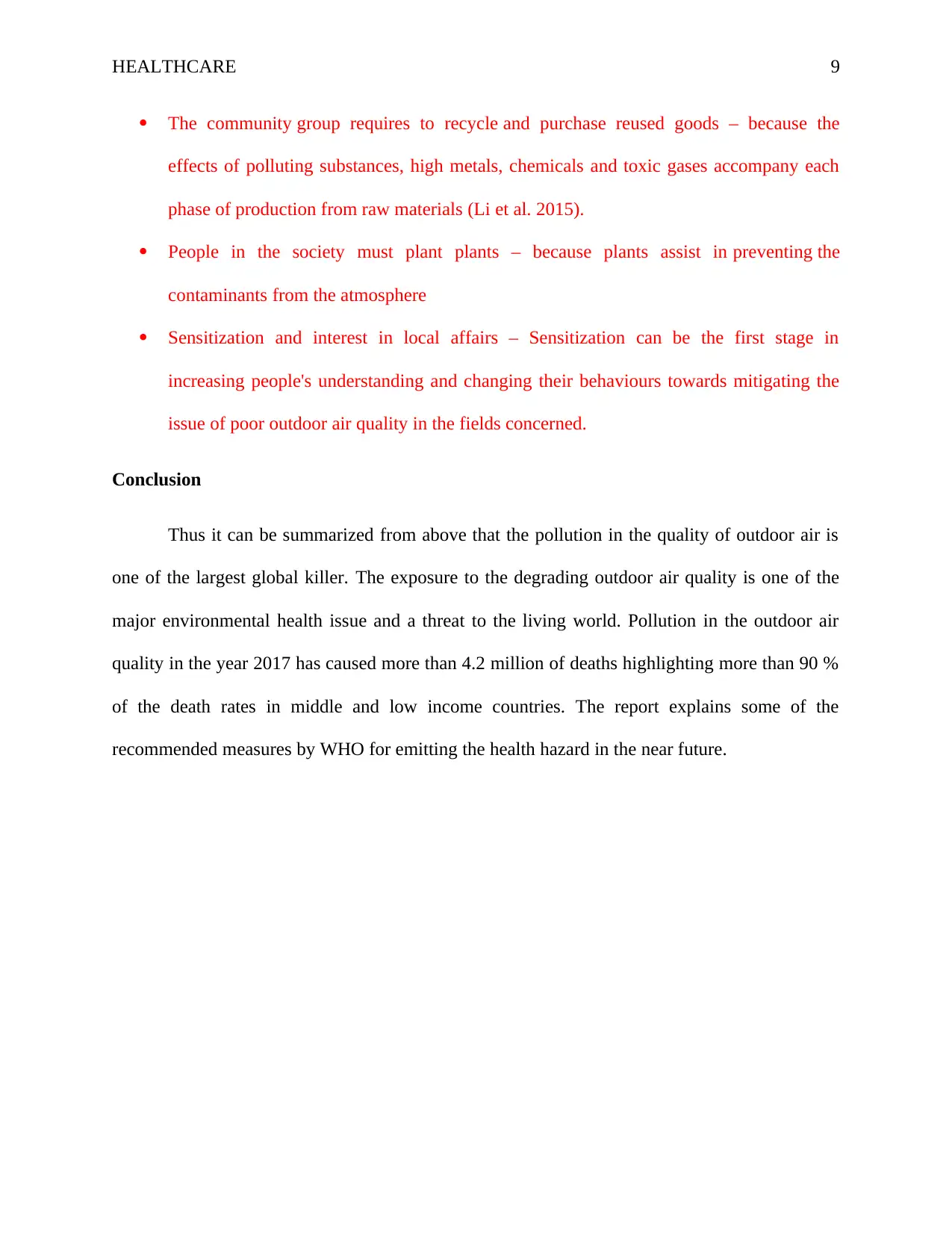
HEALTHCARE 9
The community group requires to recycle and purchase reused goods – because the
effects of polluting substances, high metals, chemicals and toxic gases accompany each
phase of production from raw materials (Li et al. 2015).
People in the society must plant plants – because plants assist in preventing the
contaminants from the atmosphere
Sensitization and interest in local affairs – Sensitization can be the first stage in
increasing people's understanding and changing their behaviours towards mitigating the
issue of poor outdoor air quality in the fields concerned.
Conclusion
Thus it can be summarized from above that the pollution in the quality of outdoor air is
one of the largest global killer. The exposure to the degrading outdoor air quality is one of the
major environmental health issue and a threat to the living world. Pollution in the outdoor air
quality in the year 2017 has caused more than 4.2 million of deaths highlighting more than 90 %
of the death rates in middle and low income countries. The report explains some of the
recommended measures by WHO for emitting the health hazard in the near future.
The community group requires to recycle and purchase reused goods – because the
effects of polluting substances, high metals, chemicals and toxic gases accompany each
phase of production from raw materials (Li et al. 2015).
People in the society must plant plants – because plants assist in preventing the
contaminants from the atmosphere
Sensitization and interest in local affairs – Sensitization can be the first stage in
increasing people's understanding and changing their behaviours towards mitigating the
issue of poor outdoor air quality in the fields concerned.
Conclusion
Thus it can be summarized from above that the pollution in the quality of outdoor air is
one of the largest global killer. The exposure to the degrading outdoor air quality is one of the
major environmental health issue and a threat to the living world. Pollution in the outdoor air
quality in the year 2017 has caused more than 4.2 million of deaths highlighting more than 90 %
of the death rates in middle and low income countries. The report explains some of the
recommended measures by WHO for emitting the health hazard in the near future.
Secure Best Marks with AI Grader
Need help grading? Try our AI Grader for instant feedback on your assignments.
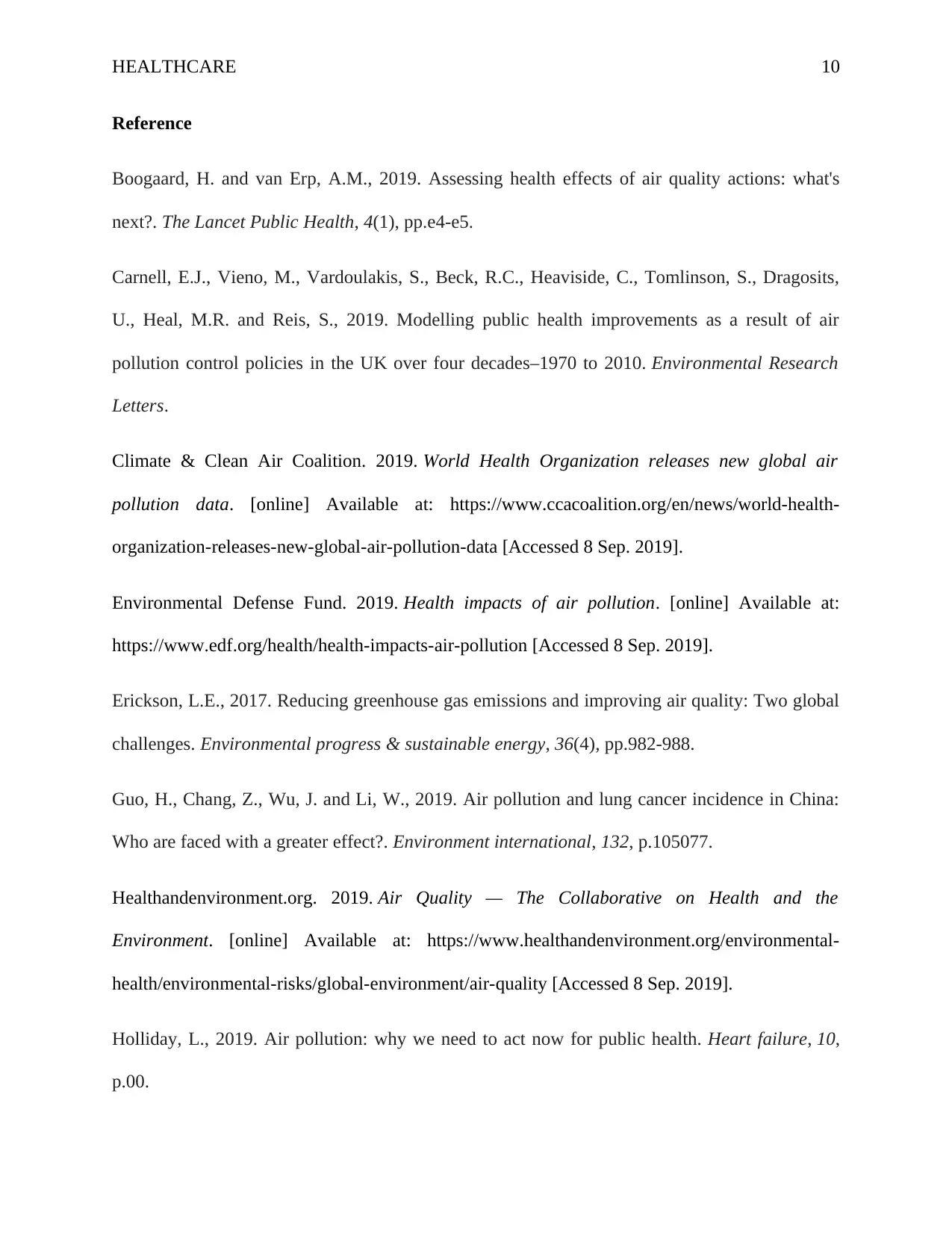
HEALTHCARE 10
Reference
Boogaard, H. and van Erp, A.M., 2019. Assessing health effects of air quality actions: what's
next?. The Lancet Public Health, 4(1), pp.e4-e5.
Carnell, E.J., Vieno, M., Vardoulakis, S., Beck, R.C., Heaviside, C., Tomlinson, S., Dragosits,
U., Heal, M.R. and Reis, S., 2019. Modelling public health improvements as a result of air
pollution control policies in the UK over four decades–1970 to 2010. Environmental Research
Letters.
Climate & Clean Air Coalition. 2019. World Health Organization releases new global air
pollution data. [online] Available at: https://www.ccacoalition.org/en/news/world-health-
organization-releases-new-global-air-pollution-data [Accessed 8 Sep. 2019].
Environmental Defense Fund. 2019. Health impacts of air pollution. [online] Available at:
https://www.edf.org/health/health-impacts-air-pollution [Accessed 8 Sep. 2019].
Erickson, L.E., 2017. Reducing greenhouse gas emissions and improving air quality: Two global
challenges. Environmental progress & sustainable energy, 36(4), pp.982-988.
Guo, H., Chang, Z., Wu, J. and Li, W., 2019. Air pollution and lung cancer incidence in China:
Who are faced with a greater effect?. Environment international, 132, p.105077.
Healthandenvironment.org. 2019. Air Quality — The Collaborative on Health and the
Environment. [online] Available at: https://www.healthandenvironment.org/environmental-
health/environmental-risks/global-environment/air-quality [Accessed 8 Sep. 2019].
Holliday, L., 2019. Air pollution: why we need to act now for public health. Heart failure, 10,
p.00.
Reference
Boogaard, H. and van Erp, A.M., 2019. Assessing health effects of air quality actions: what's
next?. The Lancet Public Health, 4(1), pp.e4-e5.
Carnell, E.J., Vieno, M., Vardoulakis, S., Beck, R.C., Heaviside, C., Tomlinson, S., Dragosits,
U., Heal, M.R. and Reis, S., 2019. Modelling public health improvements as a result of air
pollution control policies in the UK over four decades–1970 to 2010. Environmental Research
Letters.
Climate & Clean Air Coalition. 2019. World Health Organization releases new global air
pollution data. [online] Available at: https://www.ccacoalition.org/en/news/world-health-
organization-releases-new-global-air-pollution-data [Accessed 8 Sep. 2019].
Environmental Defense Fund. 2019. Health impacts of air pollution. [online] Available at:
https://www.edf.org/health/health-impacts-air-pollution [Accessed 8 Sep. 2019].
Erickson, L.E., 2017. Reducing greenhouse gas emissions and improving air quality: Two global
challenges. Environmental progress & sustainable energy, 36(4), pp.982-988.
Guo, H., Chang, Z., Wu, J. and Li, W., 2019. Air pollution and lung cancer incidence in China:
Who are faced with a greater effect?. Environment international, 132, p.105077.
Healthandenvironment.org. 2019. Air Quality — The Collaborative on Health and the
Environment. [online] Available at: https://www.healthandenvironment.org/environmental-
health/environmental-risks/global-environment/air-quality [Accessed 8 Sep. 2019].
Holliday, L., 2019. Air pollution: why we need to act now for public health. Heart failure, 10,
p.00.
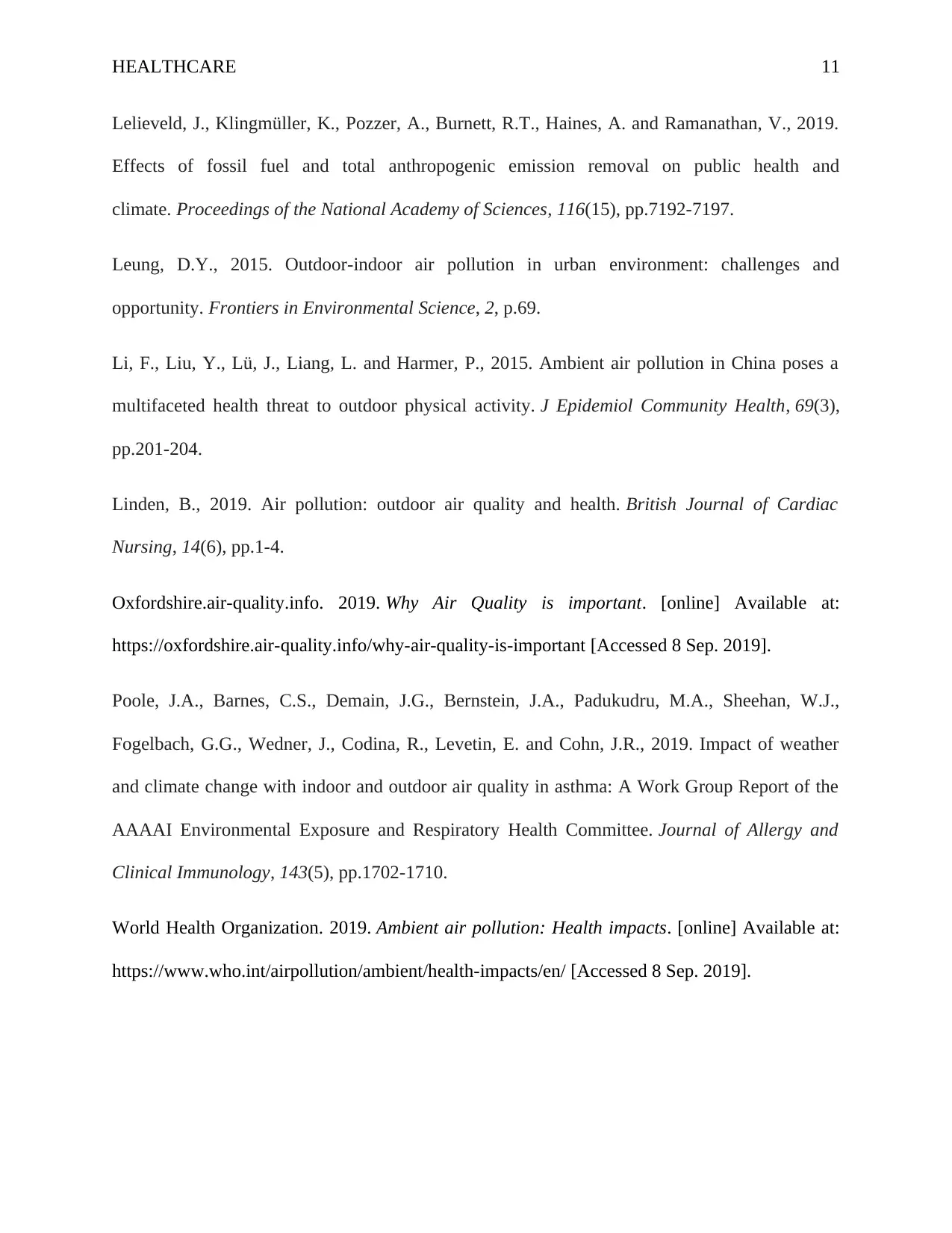
HEALTHCARE 11
Lelieveld, J., Klingmüller, K., Pozzer, A., Burnett, R.T., Haines, A. and Ramanathan, V., 2019.
Effects of fossil fuel and total anthropogenic emission removal on public health and
climate. Proceedings of the National Academy of Sciences, 116(15), pp.7192-7197.
Leung, D.Y., 2015. Outdoor-indoor air pollution in urban environment: challenges and
opportunity. Frontiers in Environmental Science, 2, p.69.
Li, F., Liu, Y., Lü, J., Liang, L. and Harmer, P., 2015. Ambient air pollution in China poses a
multifaceted health threat to outdoor physical activity. J Epidemiol Community Health, 69(3),
pp.201-204.
Linden, B., 2019. Air pollution: outdoor air quality and health. British Journal of Cardiac
Nursing, 14(6), pp.1-4.
Oxfordshire.air-quality.info. 2019. Why Air Quality is important. [online] Available at:
https://oxfordshire.air-quality.info/why-air-quality-is-important [Accessed 8 Sep. 2019].
Poole, J.A., Barnes, C.S., Demain, J.G., Bernstein, J.A., Padukudru, M.A., Sheehan, W.J.,
Fogelbach, G.G., Wedner, J., Codina, R., Levetin, E. and Cohn, J.R., 2019. Impact of weather
and climate change with indoor and outdoor air quality in asthma: A Work Group Report of the
AAAAI Environmental Exposure and Respiratory Health Committee. Journal of Allergy and
Clinical Immunology, 143(5), pp.1702-1710.
World Health Organization. 2019. Ambient air pollution: Health impacts. [online] Available at:
https://www.who.int/airpollution/ambient/health-impacts/en/ [Accessed 8 Sep. 2019].
Lelieveld, J., Klingmüller, K., Pozzer, A., Burnett, R.T., Haines, A. and Ramanathan, V., 2019.
Effects of fossil fuel and total anthropogenic emission removal on public health and
climate. Proceedings of the National Academy of Sciences, 116(15), pp.7192-7197.
Leung, D.Y., 2015. Outdoor-indoor air pollution in urban environment: challenges and
opportunity. Frontiers in Environmental Science, 2, p.69.
Li, F., Liu, Y., Lü, J., Liang, L. and Harmer, P., 2015. Ambient air pollution in China poses a
multifaceted health threat to outdoor physical activity. J Epidemiol Community Health, 69(3),
pp.201-204.
Linden, B., 2019. Air pollution: outdoor air quality and health. British Journal of Cardiac
Nursing, 14(6), pp.1-4.
Oxfordshire.air-quality.info. 2019. Why Air Quality is important. [online] Available at:
https://oxfordshire.air-quality.info/why-air-quality-is-important [Accessed 8 Sep. 2019].
Poole, J.A., Barnes, C.S., Demain, J.G., Bernstein, J.A., Padukudru, M.A., Sheehan, W.J.,
Fogelbach, G.G., Wedner, J., Codina, R., Levetin, E. and Cohn, J.R., 2019. Impact of weather
and climate change with indoor and outdoor air quality in asthma: A Work Group Report of the
AAAAI Environmental Exposure and Respiratory Health Committee. Journal of Allergy and
Clinical Immunology, 143(5), pp.1702-1710.
World Health Organization. 2019. Ambient air pollution: Health impacts. [online] Available at:
https://www.who.int/airpollution/ambient/health-impacts/en/ [Accessed 8 Sep. 2019].
1 out of 12
Related Documents
Your All-in-One AI-Powered Toolkit for Academic Success.
+13062052269
info@desklib.com
Available 24*7 on WhatsApp / Email
![[object Object]](/_next/static/media/star-bottom.7253800d.svg)
Unlock your academic potential
© 2024 | Zucol Services PVT LTD | All rights reserved.





